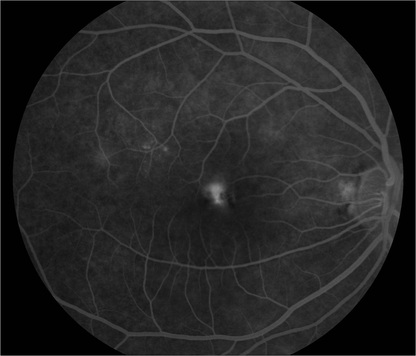Central Serous Chorioretinopathy (CSR)
- Copyright 2007, Retinal Diagnostic Center.

What is Central Serous Retinopathy?
Central Serous Retinopathy (CSR) usually affects young men and women in their 30’s, 40’s and 50’s. The symptoms are at the center of the field of vision – blurring, distortion, minification of objects and a dark patch at fixation. It presents with fluid spontaneously leaking into the sub-retinal space from the choroid.The retina lies on top of a large layer of tissue packed with blood vessels and capillaries called the choroid. The choroid is functionally separated from the retina by a membrane (Bruch’s Membrane) and a single layer of cells called the retinal pigment epithelium (RPE). This layer works like a barrier facilitating nutrients to flow into the retina from the underlying vessels. It also allows retinal wastes to leave for removal by the choroidal vessels. The RPE layer prevents free flow of fluid. In CSR, this seal breaks down, and fluid leaks into the sub-retinal space.This can occur in both eyes but usually presents in one at a time. After a couple of months' time, the condition may resolve on its own. Once someone has had an initial episode, there is up to a 50% chance of having a recurrent episode in either eye. Recurrent episodes in the same location or a persistent leak in a single location can cause permanent damage to vision. A rare but serious complication occurs when scar tissue and blood vessels from the choroid invade the space under the retina. This tissue, if not stopped, can continue to grow and destroy the central retina (or macula). This occurs more commonly in older patients with recurrences.
What are the causes?
There is a lot of speculation about what causes Central Serous Retinopathy. Dogma would suggest that stress might play a large part in its development. At our clinic, we have found that patients do not always feel stressed, and CSR may be more related to being worn out or run down. It occurs more frequently in patients who have too many things on their plate, and usually is associated with lack of sleep. Most patients will report 5 to 6 hours of sleep at night rather than the recommended 8 hours.Prolonged and consistent lack of sleep can shorten your life span. Exposure to any steroid medication (nasal spray, cortisone cream, joint injection, etc) has also been associated.
What are the treatments?
Treatment for central serous retinopathy is currently done in one of three ways.
Observation
Observation is often used in the first month or two to see whether central serous retinopathy might clear on its own. The patient should attempt to get 8 hours of sleep a night by setting a routine bedtime. Routine exercise seems to help induce a more regular sleep cycle.
Laser Treatment
Laser treatment for central serous retinopathy has been one of the mainstays of active therapy. The idea is that with a slight amount of thermal laser stimulation, the RPE cells may scar, and the fluid leak stop. This treatment can be used at any time after the diagnosis of central serous retinopathy. It is indicated earlier in cases with vision in only one eye, and that eye is affected by central serous retinopathy. A prime candidate for immediate treatment might be an individual who cannot perform their regular tasks while visually impaired – for example, an airline pilot.
Photodynamic Therapy (Visudyne)
This treatment seems to be quite effective in some cases of central serous retinopathy and does not leave the same scarring that laser can. A Visudyne treatment appears to be potentially effective not only against central serous but also against the rare complication of a sub retinal neovascular membrane or scar tissue growing underlying the leak in the eye. Visudyne is injected in the vein and preferentially binds to abnormal blood vessel. A "cold laser" is then used to activate the drug and close off abnormally leaky vessels.
Copyright 2007, Retinal Diagnostic Center.
SCHEDULE ONLINE
Or
SCHEDULE VIA PHONE CALL
Recent Posts
- - The FDA approved the first ever treatment for dry macular degeneration patients with geographic atrophy. Link here
- - DRCR-Retina Network Protocol AC showed diabetic macular edema patients starting on Eylea vs. those switching after Avastin fails can achieve a similar visual outcome. Link here
- - DRCR-Retina Network Protocol AB showed both initial aflibercept and vitrectomy with panretinal photocoagulation are viable treatment approaches for Proliferative diabetic retinopathy (PDR)-related vitreous hemorrhage. Link here